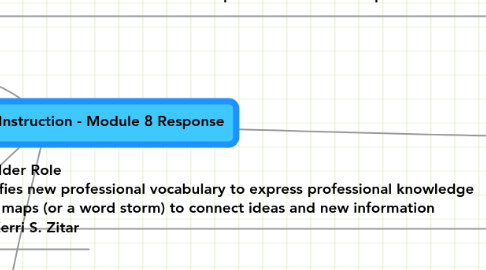
1. Vocabulary Builder Role This role identifies new professional vocabulary to express professional knowledge Builds concept maps (or a word storm) to connect ideas and new information
2. by Kerri S. Zitar
3. Phonemic awareness is the awareness that spoken words are composed of individual sounds/phonemes
4. Looks Like..
4.1. Whole group direct instruction
4.1.1. Circle time activities
4.1.2. Shared reading
4.1.3. Shared writing
4.2. Small group direct instruction
4.2.1. Reading groups
4.2.2. Groups based on interest - eg: theme groups (transportation, ladybugs, dinosaurs, etc)
4.3. Individual direct instruction
4.4. Literacy based play
4.4.1. Story book props for dramatic play
4.4.2. theme props for dramatic play
4.4.2.1. Pizza Parlor
4.4.2.2. Grocery Store
4.4.2.3. Movie Theater
4.4.2.4. Post Office
4.5. Whole group games
4.5.1. Telephone
4.5.2. Songs
4.5.3. Riddles and Rhymes
5. Feels Like...
5.1. Children feel safe in order to explore new situations
5.2. Child directed activities
5.3. Teacher directed activities
5.4. Fun
5.5. Excitement about learning
5.6. Adventure
5.7. Pride - children feel a sense of pride and ownership over their knowledge
5.8. Lots of discussion
5.9. Lots of movement
6. Sounds Like...
6.1. phoneme isolation -focus children's attention on individual phonemes (the smallest units of sound) that make up words
6.1.1. Sound matching - children decide which of several words begins with a specific sound
6.1.1.1. eg - Teacher shows pictures of familiar objects (book, car, dog) and asks which begins with the /b/ sound
6.1.2. Sound isolation - children are given words and asked to identify what sound they hear at the beginning, middle or end
6.1.2.1. eg - teacher asks, "What is the sound you hear that starts these words: car, cat, cake?"
6.2. phoneme blending - children combine individual sounds to form words
6.2.1. "What am I Thinking of" game
6.2.1.1. eg - Teacher tells class he is thinking of an animal. He then says the name of the animal in separate phonemes, /d/ /o/ /g/. Children are then asked to blend the sounds together to come up with the name of the animal
6.3. phoneme segmenting - the opposite of phoneme blending. Children deconstruct words into individual sounds
6.3.1. Teacher can provide students with counters and Elkonin boxes. Children are asked to place counters in the boxes to represent each sound in the word
6.3.1.1. Elkonin boxes - a diagram of three blank squares representing the beginning, middle and ending sounds in a word
6.3.1.1.1. These concrete props make this abstract activity easier for children.
6.3.1.2. eg - For the word bat, a marker would be placed in the left hand square for the /b/, another in the center square for /a/, and a third in the right-hand square for a /t/.
6.4. phoneme manipulation - most advanced form of phonemic awareness
6.4.1. phoneme addition - say a word and then say it again with a phoneme added at the beginning or end
6.4.1.1. an > fan or an > ant
